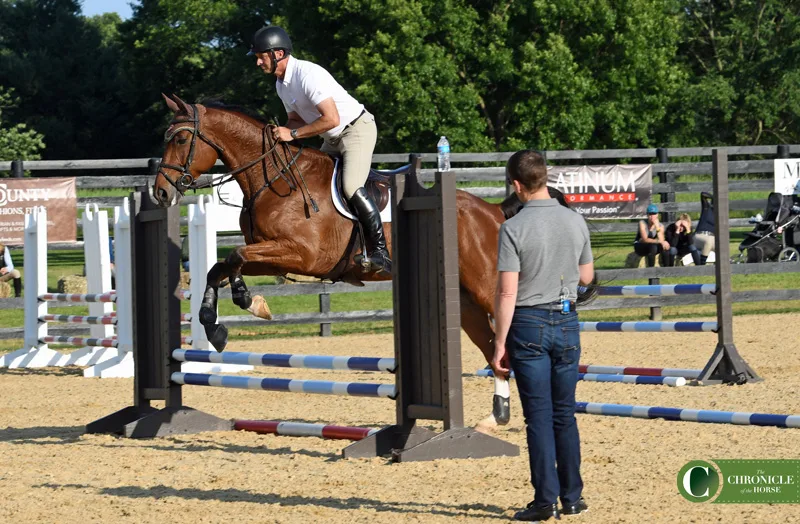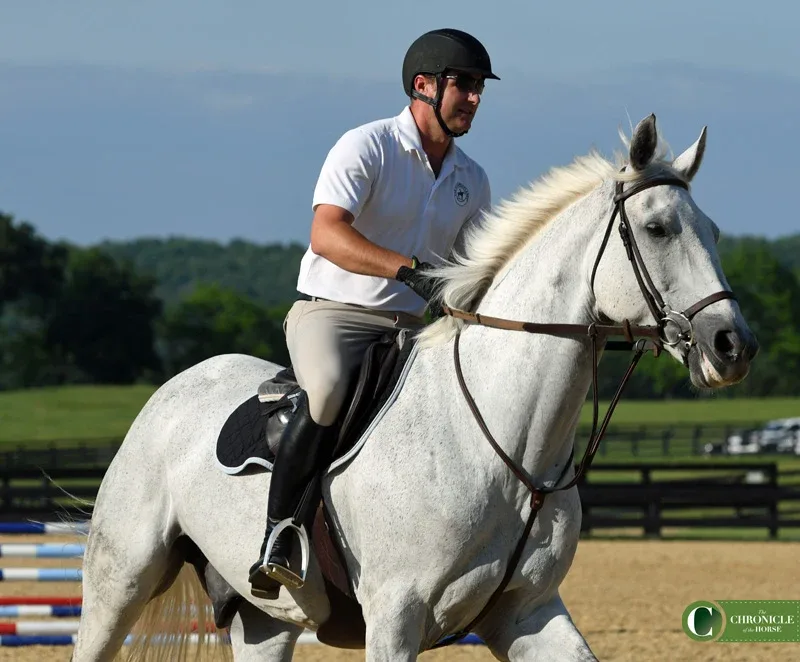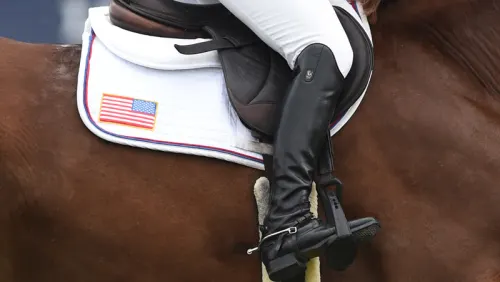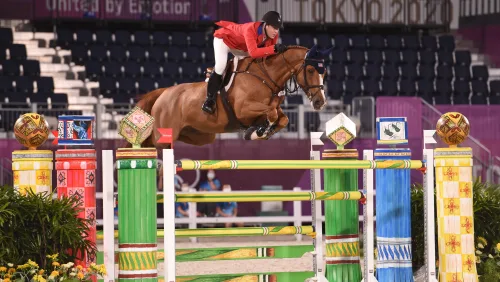Middleburg, Va.—June 6
It would have been easy for McLain Ward to jack up the fences and put together a challenging course for his clinic at Rutledge Farm. After all, all four riders in attendance compete in grand prix classes themselves and brought experienced mounts. Instead Ward dialed it back, looking at the small details that compound themselves and often lead to mistakes.

McLain Ward (standing) with clinic participants (from left) Matt Hollberg, Agustin Rosales, Gavin Moylan and Tiffany Cambria. All photos by Kimberly Loushin.
Ward began the session by talking about his training philosophy while the riders warmed up. He reminded riders that warming up for a jump school is going to look different from a straight flat session. But the concepts were consistent: Get your horse loose and relaxed and then focus on getting him forward into the bridle. He encouraged riders to look at their aids on a scale from 1 to 10 and find the balance of each aid that worked for the horse in that moment.
“Each day with a horse, whether it be in training, in teaching the horse, whether it be in competition, you have to figure out what your horse can accept on the day,” said Ward. “I’m not a big fan of mentality where the horse must accept this much leg pressure, must accept the hand. I’m going to find where the horse is the most comfortable. I’m going to find where the horse feels the most balanced and where I’m going to get the best performance out of my horse. I think that’s why I’ve had a lot of success with the mares because I ask from them what I think they’re willing to accept, what they’re willing to give, not necessarily what I must have.”

None of the exercises McLain Ward set up were overly technical, but they allowed the riders to pay attention to their ride between the fences.
Ward encouraged participants to always go back to straight and forward when things got difficult. Often riders will resort to fancy lateral work or counter canter when there is a simple solution available.
“If I can have forward and straight and in a good rhythm I’m going to beat you more often than not,” Ward said.
None of the exercises Ward set up required rocket science. They started over a single crossrail, which later became a vertical. Next came a gymnastic Ward has set up in his ring year round, a 9′ ground rail to a low vertical, one stride to another vertical with a ground rail between. Then he added a short five-stride and an easy two-stride to make a small course.
Form Equals Function
Ward is known for being a stylist, and he zeroed in on the adage of “form equals function.” He reviewed the tenets we all learned in our early lessons: hands up to create a straight line to the bit; elbows in to maintain leverage against a strong horse, keep a relaxed thigh and knee with the calf on and let the horse jump to you.
ADVERTISEMENT

McLain Ward encouraged participants to focus on their position throughout the clinic by keeping their weight balanced and letting the horse bring its withers to them in the air.
“I like to keep a little bit of a relaxed knee and thigh and close lower leg,” he said. “I find if I have my calf close to the horse, I can really control how much pressure I’m putting on my seat. If I get locked in with my knee and my thigh, it’s very hard for me to control the seat, the seat’s putting more pressure than I want. Relax the knee and the thigh; keep the lower leg close, and then you can control very subtly the amount of pressure you’re putting in with your seat. The first thing we’re taught is heels down. Again, back to simple, basic riding. Heels down.”
Matt Hollberg had the tendency to lower his gaze as he rode, which caused the entire balance to fall forward on the forehand. In doing so, the gray got heavy on the landing. As a result, the recovery time between fences slows down, which makes everything else on course feel like it’s coming up quicker.
“Watch that he doesn’t get too low,” Ward cautioned. “Even in your eye level. You have the tendency to start looking down because he’s looking down, and then everything collapses. If you keep your eye level up, his whole carriage raises up. As you start to look down, your shoulders go down, his head goes down, your hands go down. Everything goes forward.”
Be Confident In Your Training
With courses becoming increasingly difficult, it’s tempting to micromanage, but in the end that ends up being counter-productive.
“The way the sport has gone with the time allowed and the careful jumping, you need to land and follow your horse—that doesn’t mean creating a lot of impulsion—follow your horse through the turn and then be balancing to the jump,” said Ward. “Not only because the jumps are super careful, but the distances are quite technical. You can’t go slow, slow, slow because you have to make the time allowed. You have to follow the horse through the turn and then always be balancing, and that doesn’t necessarily mean adding at the fence. It means compacting your horse. It’s about coiling the horse together at the end, obviously to give your horse the support for the careful fences, but also the short distances that were coming.
“Everything is tight time allowed, short distance, careful jump; that’s the direction the sport’s gone,” he continued. “With that, everything I’ve practiced is, is follow the horse through the turn, allow the horse to go, and in the end be coming back, but it doesn’t mean following and kicking at the same time. It’s just allowing the horse to go. It’s a simple thing, but if you lose the discipline there, it just unravels.”
Ward praised Agustin “Chicho” Rosales for his horse’s rideablity on the flat but cautioned Rosales, who has a dressage background, against getting too focused on controlling every step.
“You’re so concerned about the control that you have so much control here, you have to either add one or move forward,” said Ward. “I want you to relax a little, trust your horse’s gallop [through the turn] and be balancing in the end. Your dressage is brilliant. Don’t do that on course. Save that for when you’re doing flatwork.”
ADVERTISEMENT

Ward encouraged Agustin Rosales to trust his horse’s training rather than dictate every single step, and it smoothed out the entire course.
He sent Rosales back on course, reminding him that the only thing on his mind should be the approach to the fence, not worrying constantly about his horse. As Rosales jumped around the simple course, Ward struck up a conversation, asking first if he’d had breakfast before launching into a goofy interrogation about the contents of Rosales’ meal.
Initially Rosales faltered over the inquiries, but once he relaxed and allowed himself to multitask a bit his entire ride smoothed out.
“Did anybody notice his corners?” Ward asked. “It was a stupid conversation, but it took his mind off of working his horse every stride on the course. It distracted you for just a moment that you weren’t flatting your horse between every fence.
“You work a horse beautifully on the flat; you’ve got to trust that; you can’t flat around the whole course,” he added. “Once you’re on course you’ve got to trust what you’ve trained and allow your horse to carry you, which you’ve trained him to do. Worry about rhythm, straight and being in the right speed at the fence.”
Bonus Takeaways
• “When we ask for something, particularly something in the extreme, whether it be flexion, collection, we ask the horse to really hold their carriage. When the horse gives what you’re asking for, you have to give back. That’s a problem I see with juniors and amateurs; they ask for something, and they get a little; they ask for a little more; they ask for a little more. They poke, and then the horse rebels, and they say, ‘Oh why’d my horse do that?’ Because you asked for too much. You have to feel and reward a little bit. Let them be your partner, not necessarily always against.”
• “I say to my students, ‘Look where you’re going. Practice going from place to place.’ They say, ‘I will in the ring.’ I say, ‘Oh so in the training you’re not going to practice these good habits, but when you go in the ring, and you have pressure, and there’s a test, and you’re nervous, and it’s much harder, you’re going to get rid of all the bad habits?’ Even when I flat around I look, almost like I’m going to another fence. I practice when I go through the diagonals. Those are all habits. They can be good habits or bad habits.”
• “Watch that your whip also doesn’t get flying out to the side. If you’re going to carry a whip, carry it properly. Have it by your hip or your thigh, hip preferably. You don’t want the horse to see it out of the corner of its eye and overreact when you don’t want it. It’s an aid, but it should be quiet.”















